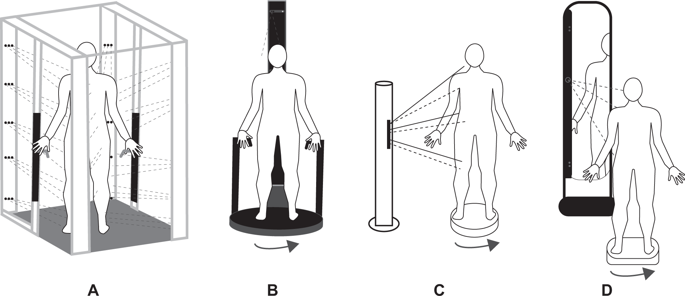European Journal of Clinical Nutrition ( IF 3.6 ) Pub Date : 2019-11-04 , DOI: 10.1038/s41430-019-0526-6 Grant M Tinsley 1 , M Lane Moore 1 , Jacob R Dellinger 1 , Brian T Adamson 1 , Marqui L Benavides 1

|
Background
Digital anthropometry is increasingly accessible due to commercial availability of three-dimensional optical scanners (3DO).
Methods
One hundred and seventy-nine participants were assessed by four 3DO systems (FIT3D®, Size Stream®, Styku®, and Naked Labs®) in duplicate, air displacement plethysmography (ADP), and dual-energy x-ray absorptiometry (DXA). Test–retest precision was evaluated, and validity of total and regional volumes was established.
Results
All scanners produced precise estimates, with root mean square coefficient of variation (RMS-%CV) of 1.1–1.3% when averaged across circumferences and 1.9–2.3% when averaged across volumes. Precision for circumferences generally decreased in the order of: hip, waist and thigh, chest, neck, and arms. Precision for volumes generally decreased in the order of: total body volume (BV), torso, legs, and arms. Total BV was significantly underestimated by Styku® (constant error [CE]: −10.1 L; root mean square error [RMSE]: 10.5 L) and overestimated by Size Stream® (CE: 8.0 L; RMSE: 8.3 L). Total BV did not differ between ADP and FIT3D® (CE: −3.9 L; RMSE: 4.2 L) or DXA BV equations (CE: 0–1.4 L; RMSE: 0.7–1.5 L). Torso volume was overestimated and leg and arm volumes were underestimated by all 3DO. No total or regional 3DO volume estimates exhibited equivalence with reference methods using 5% equivalence regions, and proportional bias of varying magnitudes was observed.
Conclusions
All 3DO produced precise anthropometric estimates, although variability in specific precision estimates was observed. 3DO BV estimates did not exhibit equivalence with reference methods. Conversely, DXA-derived total BV exhibited superior validity and equivalence with ADP.
中文翻译:

通过三维光学扫描进行数字人体测量:评估四个商用系统。
背景
由于三维光学扫描仪(3DO)的商业可用性,数字人体测量学正变得越来越容易获得。
方法
通过四个3DO系统(FIT3D®,SizeStream®,Styku®和NakedLabs®)一式两份,空气体积体积描记法(ADP)和双能X线骨密度仪(DXA)对179名参与者进行了评估。 。评估了重测的准确性,并确定了总和区域容量的有效性。
结果
所有扫描仪均得出精确的估计值,当沿圆周平均时,均方根变异系数(RMS-%CV)为1.1–1.3%,而按体积平均时,均方根变异系数为1.9–2.3%。圆周的精度通常按以下顺序降低:臀部,腰部和大腿,胸部,颈部和手臂。体积精度通常按以下顺序降低:身体总体积(BV),躯干,腿和手臂。总BV被Styku®低估(恒定误差[CE]:-10.1 L;均方根误差[RMSE]:10.5 L),而被SizeStream®高估(CE:8.0 L; RMSE:8.3 L)。ADP和FIT3D®(CE:-3.9 L; RMSE:4.2 L)或DXA BV方程(CE:0-1.4 L; RMSE:0.7-1.5 L)之间的总BV不变。所有3DO都高估了躯干体积,而低估了腿部和手臂的体积。
结论
所有3DO都产生了精确的人体测量估计值,尽管观察到了特定精确度估计值的变化。3DO BV估计值与参考方法不相等。相反,DXA衍生的总BV表现出优越的有效性和与ADP的等效性。











































 京公网安备 11010802027423号
京公网安备 11010802027423号